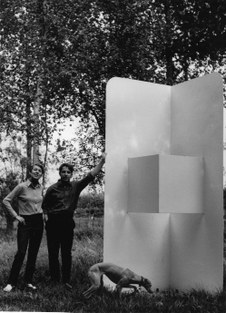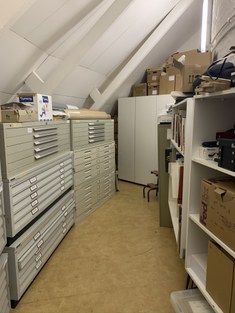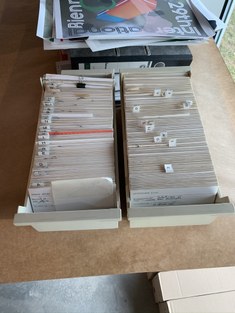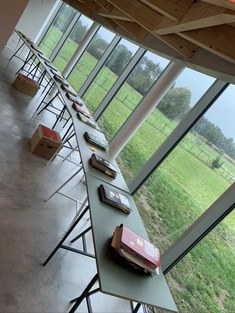Research
Plus-Kern Gallery Archives
ARCHIVE
In 2020 the archives of Plus-Kern Gallery (exhibition history, artists' correspondence, press clippings, administration) have been bequeathed to Ghent University by Jenny Van Driessche.
In collaboration with the staff of the Ghent University library, the research team KB45 / Art in Belgium since 1945 establishes an inventory, full digital scan, and study of the Plus-Kern archives. Researchers aim to disclose the role and activities of both Van Driessche and De Smet, and to situate the Plus-Kern exhibitions and associated artists within both local and international contexts.
This research project will result in a publication, exhibition and/or website.
HISTORY
Galerie Plus-Kern was an initiative of the Belgian artist Yves De Smet and his wife Jenny Van Driessche. Founded in Ghent in 1969 and baptized 'centre for constructive design,' the gallery encompassed a design shop, a graphic art department, and several exhibition spaces, in which was presented work by both Belgian and international artists. In the early years, Plus-Kern primarily promoted geometric abstraction and kinetic art, yet the gallery's focus soon shifted towards more conceptual practices. Artists centrally associated with the gallery include François Morellet (FR), Jan Schoonhoven (NL), Amédée Cortier (BE), Leo Copers (BE), and Raoul De Keyser (BE).
In 1972, following Yves De Smet's withdrawal from the gallery, Plus-Kern fell entirely under the directorship of Van Driessche. In 1973 she discontinued the gallery's activities in Ghent and opened an exhibition space in the Galerie Le Bailli, a modest shopping mall in Brussels. One later year the gallery in Brussels was terminated as well and Plus-Kern's program was brought to a halt.
In 1983 Van Driessche returned to Plus-Kern. She opened an exhibition space in a refurbished town house in Brussels, where exhibitions by both Belgian and international artists were organized. Along with established artists such as Carl Andre (US), Carel Visser (NL), and Leo Copers (BE), Van Driessche worked with a generation of young and upcoming artists, including Wim Delvoye (BE), Richard Venlet (BE), and Carlo Mistiaen (BE).
In 1992 the activities of the Gallery Plus-Kern were ended.
50 years Frans Masereel Centre, Kasterlee (BE)
In 2022 the Frans Masereel Centre (Kasterlee, BE) celebrates 50 years of existence. The institution seizes the jubilee as an opportunity to write the history of the Centre, resulting in a publication, exhibition and/or website. The research group KB45 has been appointed by the Flemish Community to write the history of the centre in preparation of the festivities in 2022.
HISTORY
The Centre has its origin in a collection of printing presses by the graphic artist Fons Mertens. In order to house these presses, he commissions the architect Lou Jansen to design a workshop for silk screen printing, lithography and engravings. In 1972, under the impulse of the State minister of Culture, Frans Van Mechelen, the building is acquired by the Belgian Government. The newly established Centre gets named after the renowned graphic designer and woodcarver Frans Masereel, who died in the same year. Studios are added to the site, so that the Centre, in addition to the existing workshop and exhibition space, can take up the function of a space for artist residencies.
Today, the Frans Masereel Centre profiles itself as "a place of creation but also a platform for the transfer of knowledge, international cooperation and research." Every year around sixty (inter)national artists stay in Kasterlee for periods of three to six weeks, where they can use the graphic workshop and the exhibition space. Over the years, the Frans Masereel Centre has built an important graphic collection and archive. Ever since its foundation in 1972, every artist has donated a work of art after a stay at the Centre. In the spring of 2019, the Frans Masereel Centre opened a new wing, designed by the Japanese architect Hideyuki Nakayama, in collaboration with Ido Avissar from the Paris agency LIST. This new building houses the digital workshop, the collection and a working space.
The Frans Masereel Centre has an extensive archive (clippings, correspondence and administration). In addition, the Centre also has a rich collection of printed matter. An inventory and study of the archive of the Centre makes it possible to sketch a detailed portrait of an institution that is both locally and internationally unique.
INTENTION
The research project on the history of the Frans Masereel Centre has a dual focus:
- cultural politics: The Frans Masereel Centre has a peripheral location: in the Kempen, near Turnhout, in the province of Antwerp. Despite it a being a local initiative, the Centre was officially established in 1972 as a National Centre by Minister of Culture Frans Van Mechelen, who was from the Kempen (Turnhout) himself. The history of the Centre offers an insight into the art and cultural politics in Belgium and Flanders of the past 50 years, as well as the tensions between local, provincial, regional and national cultural politics.
- artistic: over the years the Frans Masereel Center has welcomed almost every Belgian artist who worked with graphic and printing techniques (from Marcel Broodthaers, Roger Raveel and Jef Geys to lesser known artists), as well as many international artists. The Centre's history offers a unique lens to study the development of the graphic arts in Belgium.



